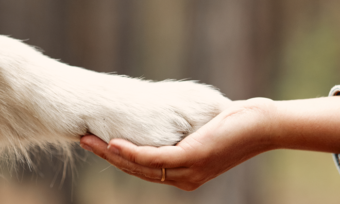
What is positive reinforcement in dog training?
Positive reinforcement is also sometimes called reward training for dogs. Essentially, it means that you reward the behaviours you want to promote and you don’t react to those you’d like your pup to stop doing.
This is similar to promoting good behaviour in humans. In human education, it’s a method that’s replacing old-school punishments. Rather than telling a first grader what he or she is doing wrong, you give them the benefit of feeling proud of what they’re doing right. Happy kids who feel good about their actions learn (and remember well). The same logic can be applied to our furry friends.
Does positive reinforcement stop aggression?
Of course, like humans, dogs might not always react the right way immediately. A dog that’s fearful or aggressive might have some baggage they need to unpack before they’re ready to learn new behaviours. This is often the case when dogs are traumatised by past experiences.
Perhaps they’ve been abandoned or abused. As a result they may experience trepidation, which they express in ways that look scary and can of course be dangerous. Stress can get in the way of their normal responses and learning. In cases like these, it’s important for the dog to first unlearn the trauma before taking on new lessons.
Can you train a dog without rewards?
With pet obesity becoming a top concern these days, you might wonder whether you can train a dog without treats?
Absolutely! Rewards don’t have to be edible treats. Dogs love humans so much and this is why simply giving your dog praise or a pat on the head is a reward in itself. Your dog doesn’t have a registry of rewards that you have to buy. Simply dote on them and show them how proud you are because that’s a reward they’ll be proud of too.
How to use positive reinforcement
Thankfully praising your dog is far easier than scolding them. At least in part. It’s both rewarding for them and you. However, the hard part is sitting tight and not doing or saying anything that could be perceived as a reaction amid ‘naughty’ behaviours. This requires patience.
So what might positive reinforcement with dogs actually look like when put into practice? Let’s look at an example of what you do to promote and reinforce good behaviour (while avoiding reacting to the ‘bad’).
- Rewarding good behaviour. Your dog comes when you call them so you give them a pat on the head, a scratch on the tummy, a treat or praise them, for example.
Sidestepping bad behaviour. Your pup is barking or jumping and you wish they’d stop. Hang in there and wait until they do then as soon as that happens, give them a reward, whatever form that may take. - Food and praise are the most commonly used rewards, although playtime is a good one as well. Because, after all, that’s what dogs value the most! Snacks and attention from their humans.
How to implement positive reinforcement for dogs
Positive reinforcement is easy to understand, but not always quite as easy to implement! To get the best results, there are a few basic principles you should follow.
- Timing. Firstly, know that your reward should be immediate. Don’t reward your dog in the afternoon for something they did well in the morning. Don’t reward them 10 minutes later either – they won’t remember or link the reward to the action. Acknowledge their good behaviours right away, i.e. seconds after they’ve listened well or done something good. This helps the dog make the connection between the behaviour and the reward. So praise or give a treat as soon as your dog shows the behaviour you want to encourage.
- Shorthand. Keep your cues short and sweet. Don’t use long sentences like “Rover, come over here and sit down nicely for me.” Just say “come” and “sit.” Make it easy for your dog to understand what you’re asking. We’re not doing language studies so much as behavioural ones!
- Consistency. Keep consistent. Don’t chop and change if you want your dog to follow what you mean. Chat with your family or household members so everyone can be in unison and use the same cues. That way there’s less opportunity for confusion from your dog’s perspective.
- Persevere. Even if your dog gets it, don’t stop rewarding them. Positive reinforcement dog training isn’t limited to behaviours, it’s also about building a connection with your dog and that connection is ongoing. Rather than suddenly forgoing the pat, the tummy tickle or playtime, keep it up. As long as you do you’re always showing your dog appreciation and they’re always feeling appreciated. Of course, if you don’t want to overdo it with feeding them using tasty treats then try to phase into rewards like pats and kisses instead of kibble or biscuits.

Benefits of positive reinforcement
There are good reasons why positive reinforcement training with dogs is an extremely popular method of getting your pooches well-behaved and happy. In fact, chances are you’ve probably used positive reinforcement even if you don’t know exactly what it is.
Reduces stress
In 2020, a Portuguese study showed companion dogs trained with positive reinforcement methods were healthier and happier than dogs trained with aversive methods. For instance, they displayed fewer stress-related behaviours and lower cortisol levels.
Improves adaptability
Dogs trained using positive reinforcement also adapted better outside the training environment than other dogs. That’s great because you want your dog to understand rather than copy good behaviours. That way they’re able to enact good behaviours in a range of different contexts.
And, of course, having a dog that’s both well-adjusted and obedient is a pleasure as a dog owner. It allows you to do exciting outings, such as off-leash hikes or beach trips, and means your bond will go from strength to strength over the years.
Other positive training tips
Keep in mind that dogs develop in stages, just like kids. Taking advantage of these milestone stages can help with your training.
Toilet training is easier with a puppy than with a mature dog, for instance. Then again if you adopt an adult dog don’t fret because the old saying that you can’t teach an old dog new tricks simply isn’t true!
When it comes to reward based training for dogs, you can teach an old dog new tricks. If your dog is traumatised from past experience it might be beneficial to bring in a pet behaviourist to help overcome those initial hurdles. Then once that’s done the positive learning can snowball.
Compare pet insurance providers here!
About the reviewer of this page
This report was reviewed by Canstar Content Producer, Caitlin Bingham. Caitlin is an experienced writer whose passion for creativity led her to study communication and journalism. She began her career freelancing as a content writer, before joining the Canstar team.
Enjoy reading this article?
You can like us on Facebook and get social, or sign up to receive more news like this straight to your inbox.
By subscribing you agree to the Canstar Privacy Policy





Share this article